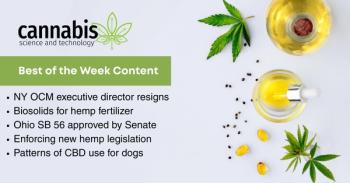
Cannabis Science and Technology
- June 2020
- Volume 3
- Issue 5
Getting Started with GxP Compliance in Your Cannabis Laboratories and Facilities
In this article, you will learn about the GxP requirements for laboratories, production facilities, and distribution of cannabis.
Any company that is involved in the cultivation, harvest, processing, analytical testing, storage, packaging, distribution, wholesale, or selling of cannabis is subject to regulatory inspections (depending on which country you operate in or distribute to), and like the rest of the pharmaceutical community adhering to good laboratory practice (GLP), good clinical practice (GCP), good manufacturing practice (GMP), and good distribution practice (GDP). Even if national regulations aren’t in place in the US, there are US state requirements, and strict regulations in some European states. From a business standpoint, ensuring quality control of temperature-sensitive cannabis products will decrease risks such as product quarantine, invalid test results, patient side effects, and ensuing legal issues. Put bluntly-your cannabis business won’t stand the test of time in this exploding industry if your practices are not GxP compliant-from laboratory to clinical to distribution. In this article, you will learn about the GxP requirements for laboratories, production facilities, and distribution of cannabis.
The supply chain of a cannabinoid product resembles that of a pharmaceutical product. Quality must be maintained throughout source of ingredients, testing in laboratories, production processing, and carefully packaged and transported products.
If quality is compromised at any step, the result will be an inferior product that jeopardizes your business, consumer trust, and, most importantly, the health of the patient. One of the most critical risk points is for laboratories storing reagents and samples in refrigerators. Like any machine, performance of a refrigerator can vary and expire. Thus resulting in a temperature deviation that could influence the results of the analytical testing.
Regulations: US
As of March 2020, 33 US states have laws allowing medical use of cannabis, plus another 14 allow the use of low tetrahydrocannabinol (THC) limited programs. In addition, 11 states also allow recreational use or “adult use” (see Figure 1). For a comprehensive state by state overview on legalized medical and “adult use” cannabis use, visit the National Conference of State Legislatures web page on marijuana laws (1).
One key good practice (GxP) standard guidance in the US is from the United States Pharmacopeia General Chapter <1029> “Good Documentation Practices” (2), that states:
- Records should be clear, concise, accurate, and legible
- Data entries should be recorded promptly when actions are performed
- No backdating or postdating
- Documentation system is needed to ensure data integrity and availability of current and archived records
Regulations: Canada
Documentation is key. As per section 231 of the Cannabis Regulations (3–5), license holders (other than cannabis drug license holders) must maintain records demonstrating their adherence to the good production practices (GPP). License holders must be able to demonstrate, using records available at the licensed site, that the activities conducted are compliant.
Have you faced a regulatory audit yet? In Canada, they started in 2017 following three recalls of cannabis for medical use related to the unauthorized use of pest control products (PCPs). Health Canada began a series of unannounced inspections and targeted testing of cannabis products from licensed producers under the Access to Cannabis for Medical Purposes Regulations to ensure that only authorized PCPs were used during the production of cannabis. Later that year, Health Canada announced it would require mandatory testing for the presence of pesticide active ingredients in all cannabis products, before the products could be sold or provided to individuals.
Regulations: Europe
There is no harmonized European Union (EU) law on cannabis use. The criminal or administrative response to drug use offences is the responsibility of EU Member States, not of the EU. For example, in 2017 the national German legislature expanded the options for prescribing medical cannabis products by passing a law amending provisions under the Narcotics Law and other regulations. These products, however, must comply with the relevant requirements laid down under the Medicinal and Narcotics Law, including good manufacturing practice (GMP) and good distribution practice (GDP). Therefore, the Federal Institute for Drugs and Medical Devices (BfArM) has taken over new responsibilities by establishing the Cannabis Agency. This agency is meant to help in ensuring supplies for medical-quality cannabis.
Since medical cannabis is considered a pharmaceutical product in all of Europe, all products must fully comply with GMP. In addition, all products must be certified by the International Organization for Standardization (ISO) both in the country in which it is produced as well as from an EU authority.
According to EudraLex: The Rules Governing Medicinal Products in the European Union, Volume 4, Good Manufacturing Practice Medicinal Products for Human and Veterinary Use (6) areas should be designed or adapted to ensure good storage conditions. It states (6), “In particular, storage areas should be clean and dry and maintained within acceptable temperature limits. Where special storage conditions are required (e.g. temperature, humidity) these should be provided, checked and monitored.”
What is GxP?
GxP is the broader umbrella for good laboratory practices (GLP), good clinical practices (GCP), GMP, and GDP.
These are sets of standards designed by regulatory agencies to control the quality and licensing for the development, manufacture, and distribution of food and drug products. Each country has their own set of GxP guidances, but overarching global agencies such as the World Health Organization (WHO), Pharmaceutical Inspection Convention (PICs), and others strive to harmonize national regulations.
GxPs and a company’s quality management system (QMS) go hand in hand. A QMS is the backbone of a company to ensure all processes and policies are focused on consistently, meeting customer requirements. In the market of human medicines, customer requirements equate to the safety, efficacy, and quality of the medicinal products. A scientifically sound and well validated QMS helps a company meet GxP guidelines. So, what do each of these mean in the cannabis industry?
GLPs for Cannabis Analytical Laboratories
GLPs ensure the uniformity, consistency, reliability, reproducibility, quality, and integrity of a chemical that is created or modified in any laboratory intended for human use.
Before cannabis is packed, labelled, and sold, legal producers have to prove that pesticides are within acceptable limits. Independent laboratories use extraction techniques to make sure that the cannabis does not go over the allowed limits of pesticides set by state or regulatory standards. The list of pesticides and the chemicals to be tested is huge, often more than 100, and acceptable limits are usually very low. Combine that with the fact that plants are grown in the earth and as a result, will have some residual levels of pesticides.
What does that mean? This is a very expensive part of the cannabis business! Tests can cost an average of $1000 per test. For hundreds of pesticides against the set standards, that adds up quickly. As an example, there is a list of pesticides and standards set out by Health Canada available online (7).
Proper storage in refrigerators is imperative to protect the financial value of the stock and products. In addition, GxP requires documentation that proves temperature control while in the refrigerator, in process at the laboratories, and through distribution to the consumers.
Old technology that so many laboratories still use for monitoring refrigerators or other laboratory equipment (such as chart recorders) can put GLP, and cannabis products, at risk. Manual processes for checking temperature graphs, storing paper, and writing deviation reports is subject to human handling errors. Read more about why chart recorders are not the right choice to protect your financial investment in the cited literature (8).
GMPs for Cannabis Manufacturing and Processing Facilities
GMPs are a system of procedures and documentation for the proper design, monitoring, and control of manufacturing processes and facilities to ensure each product has the identity, strength, quality, and purity that it is represented to possess. GMPs cover all aspects of production processes, personnel, and facilities:
- Materials
- Premises
- Equipment
- Storage
- Record keeping
- Staff training
- Hygiene
- How complaints are handled
- Product development
GMPs state all facilities must be environmentally controlled including temperature, humidity, and light for the storage and use of materials and products. You need to ensure products won’t freeze in winter, or bake in the attic in the summer. This means you need to temperature map that facility to learn where the hot and cold spots are, then create your monitoring program around that.
A temperature mapping study is used to measure and document the temperature distribution within a room by locating the hottest and coldest spot. According to WHO (9), “mapping may also be used to identify zones where remedial action needs to be taken; for example by altering existing air distribution to eliminate hot and cold spots.”
According to GMPs, new facilities must always undergo a mapping exercise, but there are instances that lead to a remapping of facilities, and these include: heating, ventilation, and air conditioning (HVAC) modifications, significant warehouse layout changes, extensions to facilities, and sometimes even new product lines will warrant a mapping exercise.
Keith Konya, Sr. Manager of Facilities at Express Scripts/CuraScript, learned a few good lessons by going through the mapping exercise. “We identified three hot spots which were caused by heaters blowing directly on pallet locations,” said Konya. “The heaters have been repositioned as well as pallet locations removed from service.”
GDPs for Cannabis Supply and Distribution
GDPs entail quality procedures and standard operating procedures (SOPs) that ensure consistent storage, transport, and handling of temperature sensitive products throughout the supply chain. That means even when it leaves your possession as a legal producer, your transport partners must be in compliance as well with your product quality control requirements. GDPs include:
- Qualification and validation of facilities, systems, and partners
- Deviations and changes
- Responsible persons
- Documentation and records
- Warehouses-mapping and monitoring
- Transport qualification
- Outsourced activities
- Complaints, returns
- Counterfeit and recalls
- Self-Inspection
In the GMPs section above, we discussed mapping and qualification of facilities. What about while the product is in-transit? How are you monitoring temperature control along the fragmented way? Cold chain monitoring solutions such as USB data loggers, temperature indicators, and other technology can give you peace of mind that the quality of your products is monitored after manufacture and through the supply chain.
There is a free booklet on how to navigate GDP guidelines online (10) as well as a blog post titled “GDPs – Not for the Faint-Hearted” (11).
First Steps to GxP: Temperature Mapping
Each environment is going to be slightly different. In laboratories, you will need to evaluate your refrigerators, freezers (if any), and cool rooms. For your distribution operations (GDP), you will evaluate your current warehouses facilities, transport vehicles, and boxes used for shipping.
Let’s use the example of GLP, for an analytic testing laboratory. In a laboratory, you will need to measure the environments of the rooms where the testing is conducted, and the refrigerators where the materials are stored (see Figure 2).
First, you will set up a business case to implement GLPs. This is done by assessing your current infrastructure and equipment, involving your different departments (quality, IT, finance), and quantifying financial loss if something went wrong.
Once you have a business case for why GLPs are important for your business, then you will develop user requirement specifications (URS) defining the project goals. Next, defining the layout of your laboratory facility is used to determine an implementation plan with measuring points.
A mapping study takes place for a defined time period, typically a few days or weeks, and monitors temperature in various defined locations inside the room (for example, refrigerator, warehouse, box, or container) forming the mapping grid. The mapping grid follows two principles:
- A 3-dimensional (3D) network of mapping points with consistent intervals in the x-, y-, and z-axes. WHO defines the expected distance between the mapping points.
- Additional mapping points are the expected hot and cold spots (which could be near the air outlet, door, seal, or wall)
Following the mapping plan (floor plan), the calibrated mapping loggers are configured, clearly labeled, and placed at the defined mapping points. After the defined time period, all mapping loggers are collected, the measurement curves are overlaid and the hottest and coldest spot in the room are evaluated. The mapping is successful if no temperature outside the required temperature range has been found. The hottest and coldest spots are obvious places to install sensors of the monitoring solution, since a temperature excursion at those spots would be most critical first and therefore measured first.
System Considerations
To monitor the environmental conditions of your products in refrigerators or using a central monitoring system, there are many different types of monitoring solutions that could work. Some questions to consider include:
- Wired or wireless?
- Dedicated network or WiFi?
- Cloud or local hosting?
- Local or remote alarms?
- What kind of alarms?
- Remote access
- Centralization for several sites or buildings (worldwide)?
- Other specific needs: Write down your “must have,” “should have,” and “must not have.” Leave space to comment on each requirement.
- Are all of systems user friendly? What does it mean for you?
Conclusion
Regulations exist to protect patients. Although they are resource intensive, they will continue to increase, having a resounding impact to your cannabis business. As state and eventually national requirements get stricter, your business will be set to avoid product recalls, negligent product quality policies, and possible legal action if you are GxP compliant.
Companies who get on board now, will have a significant advantage over those that try to retool their processes and SOPs later. GxPs also help build your company’s reputation and quality brand in this massively growing and competitive industry.
If the GxP requirements seem daunting, there is a lot of help out there ranging from ex-regulatory consultants to specialty firms in environmental monitoring. The point is, just get started. The early adopters of the practices used by pharmaceutical companies will be ahead of the regulatory curve and be best positioned for success in the market.
References
- National Conference of State Legislatures, State Medical Marijuana Laws; March 10, 2020
http://www.ncsl.org/research/health/state-medical-marijuana-laws.aspx . - General Chapter <1029> “General chapter on Good Documentation Practices,” in United States Pharmacopeia 35–National Formulary 30 (United States Pharmacopeial Convention, Rockville, Maryland, 2011).
https://laws-lois.justice.gc.ca/eng/Regulations/SOR-2018-144/page-38.html#h-849527 .- Health Canada Regulations, Cannabis Regulations: SOR/2018-144;
http://www.gazette.gc.ca/rp-pr/p2/2018/2018-07-11/html/sor-dors144-eng.html . http://www.gazette.gc.ca/rp-pr/p2/2018/2018-07-11/html/sor-dors144-eng.html .- European Commission Health and Consumers Directorate-General, EudraLex: The Rules Governing Medicinal Products in the European Union. Volume 4, Good Manufacturing Practice Medicinal Products for Human and Veterinary Use. (Brussels, Belgium, 2010).
https://www.canada.ca/en/public-health/services/publications/drugs-health-products/cannabis-testing-pesticide-requirements.html .https://www.elpro.com/fileadmin/Docs/WP_and_CS_collection/WP_LosingEverything-ChartRecorder_V1E.pdf?utm_source=publication_Cannabis_Science_and_Technology&utm_medium=WP__LosingEverything_ChartRecorder&utm_campaign=Cannabis_Science_and_Technology .- WHO Technical Report Series, No. 961, 2011 Annex 9: Model guidance for the storage and transport of time and temperature–sensitive pharmaceutical products.
https://www.who.int/medicines/areas/quality_safety/quality_assurance/TS-mapping-storage-areas-final-sign-off-a.pdf . https://www.research.net/r/C892JJ9 https://www.elpro.com/leading-minds-network/detail/good-distribution-practices-gdps-not-for-the-faint-hearted/?utm_source=publication_Cannabis_Science_and_Technology&utm_medium=LMN_good_distribution_practices&utm_campaign=Cannabis_Science_and_Technology .- Wikipedia, “Legality of cannabis by U.S. jurisdiction,”
https://en.wikipedia.org/wiki/Legality_of_cannabis_by_U.S._jurisdiction .
About the Author
Benoit (Ben) Chedhomme supports life science companies to protect their temperature sensitive products from cold chain failure. His main expertise is on validation of facilities or equipment and temperature monitoring for storage and transportation. Benoît also performs many compliance assessment projects for pharmaceutical companies to evaluate the different options that could be implemented to reach regulatory compliance. Benoît is currently the Canadian Territory Manager at ELPRO, who provides monitoring for small laboratories with stand-alone equipment, as well as multi-national projects requiring cold chain monitoring, thermal mapping, and facility monitoring systems. Direct correspondence to:
How to Cite this Article
B. Chedhomme, Cannabis Science and Technology 3(5), 32-35 (2020).
Articles in this issue
over 5 years ago
Hope on the Hemp Testing Horizonover 5 years ago
Everything Old is New Again: Cannabis Returns to USPover 5 years ago
A Tribute to the Life and Legacy of Charlotte Figiover 5 years ago
A Chemist’s Guide to the COVID-19 Outbreakover 5 years ago
Spring 2020 CANN Virtual Symposium Meeting ReportNewsletter
Unlock the latest breakthroughs in cannabis science—subscribe now to get expert insights, research, and industry updates delivered to your inbox.





